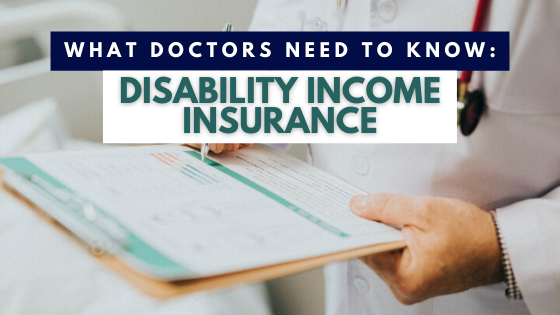Your greatest financial asset isn’t your home or even your portfolio. It’s your ability to earn an income.
Years of training and the value of your specialty represent millions in future earnings. Protecting that earning power is a cornerstone of a sound financial plan. One of the most effective tools is disability income insurance.

If injury or illness prevents you from practicing, your obligations — mortgage, tuition, daily living costs — continue. Income disability insurance replaces a portion of your earnings so your plans and your family’s lifestyle can stay on track.
Here's a quick breakdown of short-term disability income insurance vs long-term disability income insurance:
| Type | When It Starts | Typical Duration | Use Case |
|---|---|---|---|
| Short-Term Disability (STD) | ~7–14 days after disability | Up to ~90–180 days | Bridges immediate needs |
| Long-Term Disability (LTD) | Typically after 90 days (elimination period) | To age 65 (or longer, depending on policy) | Core protection for physicians |
Hospitals and medical groups often provide group LTD that targets about 45–65% of gross income and may cap the monthly benefit (commonly $5,000–$10,000). Consider the following when evaluating your protection:
Dr. Smith, a general surgery resident, has a group benefit of $2,500/month. Since the employer pays the premium, the benefit is taxable, reducing the approximate amount received to approximately $1,875/month (for illustration purposes, assuming a notional tax rate). To improve protection, residents often add a starter individual policy with a future increase option.
Once in practice at $200,000/year, Dr. Smith’s group plan covers 60% but is capped at $6,000/month. After tax, that might net roughly $4,200/month; well below her prior take-home pay. An individual own‑occupation policy can close this gap and can be adjusted as income grows.
As long as you pay premiums on time, the insurer can’t cancel coverage or raise your base rate because of a change in health.
*Disability income insurance riders are available at an additional cost and subject to state availability.
“I told myself it would never happen to me.”
Dr. Jones*, a surgeon in North Carolina, injured a finger in a pickup basketball game, ending his surgical work as his injury would no longer allow him to perform delicate and complex surgeries.
Because he had kept his own‑occupation coverage current since purchasing it as a resident, he transitioned to part‑time non‑surgical work and maintained close to his prior income through disability benefits.
*Name and specialty changed for confidentiality.
It’s insurance that pays a benefit if you’re unable to work due to a covered injury or illness. For physicians, specialty‑specific protection is especially important.
Group and individual policies together often target about 45–65% of gross income (policy and underwriting limits apply). High-income earners may add riders and future‑increase options to keep pace with income growth.
Own‑occupation (own‑specialty) pays if you can’t perform your specialty, even if you work elsewhere. Any occupation pays only if you can’t perform any suitable job.
Generally, if your employer pays the premium, benefits are taxable when received. If you pay premiums with after‑tax dollars, benefits are typically tax‑free. (Confirm with your tax advisor; see IRS reference.)
Yes. Many carriers offer early‑career policies with future increase options and portability. Availability, limits, and features vary by carrier and program.
From training through late career, disability insurance income coverage is a foundational risk management tool. If you haven’t reviewed your policy language, caps, tax treatment, and rider options recently, now is a good time, especially as your compensation and responsibilities evolve.
Protect the asset that funds your life and legacy — your income.
References
A disability income policy has exclusions and limitations. For costs and complete details of coverage, call 704-557-8750.
Individual disability income insurance does not coordinate with group long term disability coverage. Claim decisions are rendered independent of each other.
Policy availability, definitions, caps, tax treatment, and riders vary by carrier and jurisdiction. Consult your policy contract and advisors. This content is educational and not individualized advice.
*This blog was originally published on December 4, 2019, and has been updated for accuracy on October 20, 2025
CRN202810-9630434

John Dameron, RICP®, CLTC, is a partner at Spaugh Dameron Tenny and a trusted financial advisor to executives, physicians, healthcare professionals, and retirees nationwide. With over 25 years of experience, John combines technical expertise with a coaching mindset to help clients reduce financial stress, clarify their goals, and implement practical, values-based strategies for lasting impact.
John is the author of The Residents and Fellows Financial Survival Guide and a popular speaker at medical centers and teaching hospitals across the country. Known for his patient, methodical approach, he equips clients to make confident, informed decisions, helping them to align their finances with their purpose and achieve long-term success.
Too often, people make life insurance decisions under pressure, driven by fear or confusion, when they should base them on careful analysis. In this ...
Read More →Life changes fast – marriage, divorce, a new child, retirement, or a career transition. But one thing that shouldn’t fall through the cracks is your ...
Read More →For doctors and their spouses, the life insurance application process can feel daunting and invasive as you may endure answering very personal ...
Read More →